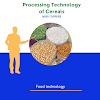PROCESSING OF MILLETS
INTRODUCTION
Millets have been utilized for human food for prehistoric times. In India, virtually all of the pearl millet and most of the finger millet is directly consumed as human food. The most important use of pearl millet grain is in baking chapattis or rotis. Millet grain is also used for production of rice- like products and porridges. Pearl millet is also used to produce malt and alcoholic beverages. Millet flour has been successfully incorporated into cutlets, pakoras, weaning foods and biscuits.
POSTHARVEST PROCESSING
STORAGE
Millets are harvested, dried and stored intact in storage bins. Usually, the millet heads are pounded in a mortar and pestle, winnowed and the grains required for daily consumption is further processed (dehulled and ground) in the mortar and pestle as needed. Millets are traditionally stored in clay pots or raised huts. Millets have reputation of being less susceptible to the insect attack than other grains. This is due to small size of millet grains. The another reason id that they are commonly grown in semi arid areas of the world where the relative humidity is typically less than 40%, which is not optimum for many
pests.
MILLING
Milling separates the grain into three components:
Germ
Endosperm and
Seed coat.
Milling techniques practiced mostly depend on the end-use. Milling process involves following steps:
1) Cleaning: Cleaning of the grains to remove unwanted impurities and broken grains, using
vibratory sieves, aspirators and specific gravity separators.
2) Conditioning: Conditioned of the cleaned grains by addition of water, to soften the endosperm.
3) Grinding: In developing countries, millets are normally decorticated and ground with mortar and pestle prior to use. Grinding stones are also used, followed by winnowing or washing at various stages of grinding to remove bran, coarse particles and fine particles. These milling techniques are labour intensive. In India, stone hand grinder, consisting of two round stones rotating horizontally against each other is used for grinding millets. Millets are also decorticated with abrasive discs in mechanical huller and ground into flour with attrition or hammer mills.
The endosperm is recovered in the form of grits, with the minimum production of flour.
Yields of various fractions from the milling process are:
Grit- 76.7%
Bran- 1.2%
Germ,-11%
Fibre- 10%.















0 Comments
Send feedback